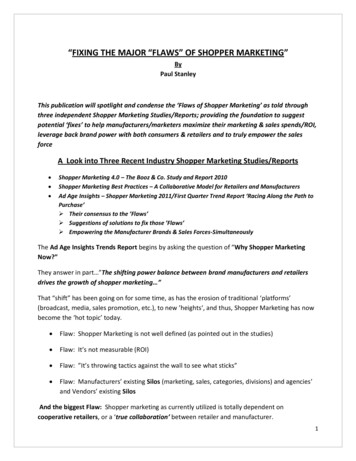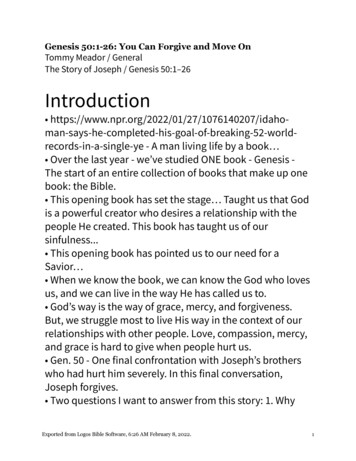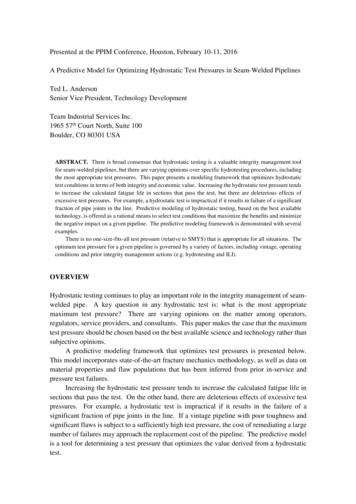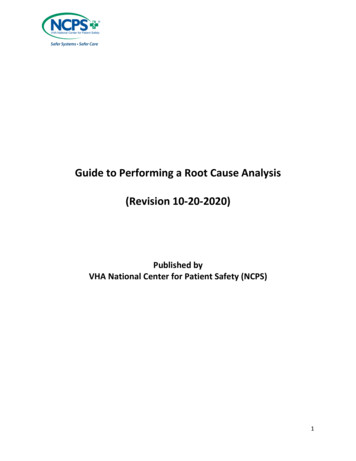
Transcription
“FIXING THE MAJOR “FLAWS” OF SHOPPER MARKETING”ByPaul StanleyThis publication will spotlight and condense the ‘Flaws of Shopper Marketing’ as told throughthree independent Shopper Marketing Studies/Reports; providing the foundation to suggestpotential ‘fixes’ to help manufacturers/marketers maximize their marketing & sales spends/ROI,leverage back brand power with both consumers & retailers and to truly empower the salesforceA Look into Three Recent Industry Shopper Marketing Studies/Reports Shopper Marketing 4.0 – The Booz & Co. Study and Report 2010Shopper Marketing Best Practices – A Collaborative Model for Retailers and ManufacturersAd Age Insights – Shopper Marketing 2011/First Quarter Trend Report ‘Racing Along the Path toPurchase’ Their consensus to the ’Flaws’ Suggestions of solutions to fix those ’Flaws’ Empowering the Manufacturer Brands & Sales Forces-SimultaneouslyThe Ad Age Insights Trends Report begins by asking the question of “Why Shopper MarketingNow?”They answer in part ”The shifting power balance between brand manufacturers and retailersdrives the growth of shopper marketing ”That “shift” has been going on for some time, as has the erosion of traditional ‘platforms’(broadcast, media, sales promotion, etc.), to new ’heights‘, and thus, Shopper Marketing has nowbecome the ‘hot topic’ today. Flaw: Shopper Marketing is not well defined (as pointed out in the studies) Flaw: It’s not measurable (ROI) Flaw: ”It’s throwing tactics against the wall to see what sticks” Flaw: Manufacturers’ existing Silos (marketing, sales, categories, divisions) and agencies’and Vendors’ existing SilosAnd the biggest Flaw: Shopper marketing as currently utilized is totally dependent oncooperative retailers, or a ‘true collaboration’ between retailer and manufacturer.1
Without ‘true’ collaboration—all reports state & agree—‘Shopper marketing does not exist’.Yet, nothing in these studies/reports suggests how to forge/obtain that retailer collaboration.If anything, the reports further demonstrates no ’true‘ manufacturer leverage over retail—withretail power only continuing its (private label) growth—and in some cases, its devastation.The good news is that these reports did provide and acknowledged Shopper Marketingweaknesses or ‘flaws’; identifying problems, thereby allowing for potential solutions.This White Paper deals with those potential solutions.There is indeed a big opportunity for manufacturers, brands and retailers to capitalize on the RichData available today.A key in putting the power back into the manufacturer/brand is in creating exclusivemanufacturers’ Intellectual Properties, from that data, that empowers their marketing and salesthrough proprietary leverage-able platforms.Manufacturers’ Intellectual Property platforms are exactly what these studies/reports appear tobe searching or calling for that can indeed fix the ‘flaws’ in Shopper Marketing, as defined bythem.The fact is that manufacturers’ Shopper Marketing platforms can be built upon a model of presecured ROI in both sales and media and be highly measureable and accountable.The following is a brief synopsis of the ‘Flaws’ reported in all three reports from which I willdraw my conclusions and opportunities.I will be using the term SMART PLATFORMS ; an acronym for integrated platforms of Sales,Marketing And ROI Together Customized for the world of Shopper Marketing platforms;Shoppers, Manufacturers, Analysis, Retailers, Together.A SMART PLATFORM model is a manufacturers’ Intellectual Property platform that integratesboth marketing and sales objectives from the start.The model/platform creates original and perpetual content; customizes for sales and mediachannels objectives—pre-securing ROI from them both.Further, in the interest of ’True Collaboration’ (a major Tenet of Shopper Marketing and thesereports), manufacturers’ SMART platforms allow the “earned” inclusion of sales channels’marketing and sales objectives, including; individual themes, positioning, cross-aisle, loyaltyprograms and non-competitive private label.2
Manufacturers’ IP Platforms can also forge and perpetuate non-traditional brand partnerships andchannels, community/benevolent give-backs and the bringing down of the silos—internally formanufacturers, and externally—agencies, media and vendors.All of which delivers multiple and currently “unforeseen” benefits and much needed ‘Reengineered’ manufacturer, brand and sales force “power”THE STUDIES AND REPORTS—A BRIEF SYNOPSIS OF EACH AND THE OPPORTUNITIES Report 1 - Shopper Marketing 4.0-The Booz & Co. Study and Report 2010The Booz & Co. study identifies “taxonomy of shopper marketing vehicles organized into sevenmajor vehicle platforms”—49 vehicles in all—encouraging marketers to somehow “hit or miss” onthe right “Platform” creation through ’vehicle‘ combinations in hopes of delivering Brandmarketing and sales objectives—based on shopper marketing ‘insights’.Booz & Co. Shopper Marketing 4.0 Charts of Platforms and “Vehicles”In this chart, the ’hit or miss’ is most evident where the Report states, “It is crucial to have astrong measurement capability to gauge their true incremental impact” meaning, before youwaste too much money or time.3
The study offers the following definition; “insights about what shoppers want and why theybehave as they do are the currency of Shopper marketing”.I agree the data collected today can be very valuable if properly utilized in a highly focused andworkable model.The report continues, ”these ‘insights’ provide the basis for more effective calendars’ of eventsaround which annual Shopper Marketing programs can be organized and integrated”.Agreed, and the data/insights along with other available research and analytics are the ’DNA‘ ofwhat SMART PLATFORMS should be built upon to begin with for both manufacturer andretailer.Booz & Co. goes on to suggest that these ‘insights’ are now utilized to somehow build a platformmade up of some combination of the above chart of 49 vehicle choices. The choices encompassvirtually all traditional forms of marketing and sales and ’new media‘, now ranked or ‘voted upon’by marketers and agencies for their effectiveness. For instance, ‘ranked vehicles’ include off-shelfretail displays, FSIs, in-store coupons, social media, etc., and ‘somehow’ get integrated into abrand marketing and sales platform based on ‘effectiveness’ rankings, shopper insights, retailerand brand objectives.At the same time, the study states the following ’conclusion‘ to making shopper marketing work—which I believe is the most relevant part of this study—however, there are no suggestions on howto accomplish the following conclusion:“The ability to build (manufacturers’) integrated marketing efforts that work willrequire the elimination of sales and marketing silos and greater coordination acrossShopper Marketing, brand advertising, promotions, merchandising and events” I would submit that, internally, it should also include marketing, sales, brands, categories anddivisions while externally, the plethora of marketers’ agencies and vendors.But how do you bring down the silos, without having a ’lightening rod’ of sorts, or a Platform to’rally around‘, that can focus and integrate all individual ’silo’s‘ business and political objectives.I call this ‘missing piece’ ‘air traffic marketing control’.Another critical ’insight’ of the study in building this marketing and sales platform/vehicle is to:“Bring retailer strategies and store policies to bear on manufacturer strategy” and “ applyinsights to engage retailers in more effective collaborations, enabling a shift from buying intoretail programs to helping shape them”.4
They are quite correct—this is very key—only I do not believe the good people at Booz & Co. havehad to sell to, or ’help shape‘, anything at Wal-Mart, nor is it mentioned that retailer programs arehuge ‘money makers’ for retailers and created primarily for that reason (e.g. Wal-Mart in-store‘TV’).Even ‘armed’ with shopper marketing insights and some concoction of traditional marketing andpromotion vehicles in one hand, manufacturers’ sales forces still have their hat in the other handduring retail sales calls today.One means to consider in accomplishing the crucial true retail collaboration is simply to ’Fight Firewith Fire,’ or in other words, have something to ‘truly‘ leverage.For example, a retailer’s “Achilles Heel” are their competitiveness and fierce fight forconsumers and community dominance (especially today with stores competing on multiplelevels—Food, Pharmacy, Dry Goods, etc.). This competitive “Achilles Heel” insight can armmanufacturers with something to leverage with the retailer (I call it the ’Big Stick‘) totallyexclusive to the manufacturer and/or brand(s) ” retailers have to fight for every dollarthat consumers are willing to spend today”Retailers, who want to participate in an exclusive manufacturer’s/Brand marketing and salesIntellectual Platform, (or conversely, not be left out competitively), must agree to participationrequirements dictated by the brand marketer, which, first and foremost is based uponmanufacturer and brand marketing, sales and ROI objectives — and then customized for eachparticipating sales channel objectives—a ’true collaboration’ for the good of all—“you wash myback, I’ll wash yours”.The Booz & Co. report suggests a ‘wheel‘ in developing the most effective brand marketing andsales Shopper Marketing platforms or ’best practices’/ ‘course of action’ as5
The “Flaw” in the ‘best practices wheel’, here again, assumes a cooperative retailer, while inessence, continuing a subservient brand/manufacturer positioning and relationship.I would submit that the Booz & Co. ’wheel of action’ should move No. 2 to No. 4 and therefore,No. 1 remains the data/insights gathered; No. 2 becomes the exclusive creative/contentdevelopment from those insights; No. 3 becomes create/build an original Intellectual Propertybrand marketing and sales vehicle/platform; No. 4 becomes customize the brand exclusive IPplatform for retailer objectives and strategies—who EARN it through ’true collaboration’ and No.6, program execution, should provide and deliver a true ‘turnkey’ activation for both manufacturerand sales channel.The Booz & Co. model puts the manufacturer’s/ brand’s needs second to the retailer’s; promotingan inferior manufacturer negotiating position from the start, versus creating an ’equality‘ platformdelivering the ability to achieve both manufacturer and retailer objectives-Simultaneously!True CollaborationThe ideal Manufacturer Intellectual Property platform would: First and foremost be based and created upon manufacturer’s/ brands’ marketing andsales integrated objectives, utilizing shopper marketing insights, data, research . Be highly consumer targeted, based upon the brand(s) equity building positioningobjectives Empower, ’arm‘ and equip the manufacturer’s sales organization Be customized for each retailers’ objectives (nationally and locally) including each retailer’sindependent themes, positioning and objectives Allow for customization and promotion of non-competitive retailers’ private label, crossaisle and loyalty shopper program tie-ins, while heavy traffic producing Create original, exclusive and perpetual content (platform “DNA”); fully integrating alldigital/web and directing those ‘conversations’—while again, allowing for retailerparticipation Simultaneously deliver the same for media leveraging and customization opportunitieswhile satisfying media partners’ objectives Include media customizations for retailers Allow, forge and customize for synergistic brand partnerships—and the expansions,opportunities and budgets they bring Deliver a ‘Pre-Secured’ sales & media channels’ ROI Perfectly tie to, and customize for, any brand(s) campaigns—“bringing them to life” Build the Intellectual Property as a manufacturer exclusive brand marketing and salesplatform ’vehicle’ and asset—Growing, year after year Be ‘competitively self- punishing’ for retailers non participation6
Fixing the “Flaws”This paper is in no way meant to criticize the Booz & Co. Shopper Marketing 4.0 Study or thefollowing studies; on the contrary, they all do a great job of pointing out the flaws of ShopperMarketing.The Booz & Co. study and report is actually on the right track; the need to ’bring down the silosand the need to deliver true marketing and sales integration and retail collaboration—although itnever really answers exactly how to achieve either.Basically, the report is offering a shopper marketing puzzle “completed picture” on the ‘front ofthe box’Inside the box, they are suggesting a bunch of puzzle pieces for the manufacturer to try and fitinto the puzzle—‘hoping’ the right combination or ’picture‘ completion comes together early, astold through some form of measurement(yet, undefined) to ’hopefully‘ achieve marketing, salesand ROI objectives.The objective should be to replace “hope” with Pre-Secured ‘Results’ through a “completedplatform picture” from the start.The biggest missing pieces in the Booz & Co. 4.0 ’puzzle box‘ and Shopper Marketing ’discipline‘overall—they lack a retail leverage component or Manufacturers’ ’Big Stick‘ and both suggest a’trial and error‘ model of activation.In other words—instead of the manufacturer going to the retailer with the Shopper Marketing’puzzle‘ completed (a working model) to begin with, inclusive of retailers insights, data, objectives,et al they are suggesting ’taking the pieces‘ to the meeting and “see how that all goes”.Which is pretty much what already happens today, as one manufacturer recently told me,” mysales force is defeated before the even enter the meeting”-Unfortunately, he’s right.I’m suggesting just the opposite.By and large, retailers are generally anything but cooperative, and with their “power” continuingits unchecked growth, it stands to only worsen for manufacturers (also acknowledged in thestudy).7
Here’s the plain truth; the ’power‘ has firmly shifted to the sales channels—continuing to try to‘regain’ brand power through different ’combinations‘ of the same old ‘tools’, ’puzzle pieces‘ and‘platforms’—simply does NOT deliver leverage, or maximize results and ROI—and a ’newmarketing discipline it does not create’.An actual quote from one of the leading Shopper Marketing agencies in the Ad Age report states;“A lot of it is putting your hand in the tactic bag, throwing it against the wall and seeing whatsticks”.That about sums it up and that defines a marketing discipline or maximizes leverage orsuccess how?The Booz & Co. study also acknowledges that: “Significant additional operational complexity often required customizing vehicles for andselling them to, retailers”. “Building a stronger capability to integrate these vehicles is often required to maximizetheir impact”!All of which can be delivered through the creation of manufacturer Intellectual PropertiesPlatforms, with one exclusive platform customized for each retailer’s objectives—theManufacturers ‘Mother Ship’, so to speak, through pre-created customizations (tentacles) thatwere created for that purpose. The idea is NOT the creation of 12 different platforms for 12different retailers, molded from existing and over-utilized traditional platforms/events/salespromotions.It is NOT a ‘bag of tactics thrown against a wall .’ but it DOES offer content origination and prideof ownership, therefore, it OFFERS all of the flexibility required for the ‘needs’ of all stakeholdersforging true collaborationIndividual manufacturer Intellectual Property platforms can, of course, be created for a specificretailer; however, there really is not a need to do so—unless of course that retailer is going to givethat manufacturer ’the store’!Basically, all reports/studies suggest or state that if there isn’t a means for providing truecollaboration—Shopper marketing will fail.I couldn’t agree more!8
Booz & Co. 4.0 SummationShopper Marketing 4.0 suggests manufacturers’ marketing and sales take 49 marketing‘ingredients’, mixing combinations until you have a good ‘cake’, then taking that cake to Retailers,offering a piece to see if they will indeed be ‘pleased’.SMART PLATFORMS mix in the right shopper marketing ‘ingredients’ from the start and build anexclusive brand/manufacturers’ Bomb/Weapon--NOT a cake. It delivers all Stakeholdersobjectives and admittedly plays retailers competitiveness too. Why not—don’t they do the sameto manufacturers?Manufacturers have let retailers eat cake far too long—‘how’s that working for them’!Walmart now has over 500 private label categories, Walgreens 400 and you can’t find a batteryother than Duracell and private label at CVSAnd yet, the Energizer Bunny continues to beat its’ drum over and over on televisionSome are waking up.A current initiative of Procter & Gamble is in integrating their brands and seeking retail leverageprimarily through ‘strength in brand numbers’ and ‘rallying around a platform’—only they are stillutilizing existing and NON-exclusive platforms as their vehicles (e.g. NFL, Olympics)—as opposedto creating their own Intellectual Property Platforms. They are, however, unifying their brandsand divisions, focusing on regional versus national (retail competitiveness of sorts)—bring downsome silos and currently unchecked by their competitors. (Adage.com)Kudos to P & G for once again leading the way as you did when you created Intellectual PropertyPlatforms for the times, known then, as Soap Operas.Those are now gone, but on the right track you are.THE STUDIES AND REPORTS—A BRIEF SYNOPSIS OF EACH AND THE OPPORTUNITIES Report 2 - Shopper Marketing Best Practices – A Collaborative Model for Retailers andManufacturers 2010 – Retail Commission on Shopper MarketingThis industry report pretty much mirrors the same information found in the Booz &Co study.9
Key points from the RCSM Reports Executive Summary: The most essential and effective form of Shopper Marketing involves collaborationbetween retailers and product manufacturers.Collaboration may, in certain cases, begin at the strategic planning level, but more oftenwill manifest itself in the joint development of shopper-focused communication platformsand actionable marketing and merchandising programs.To fully realize the potential of shopper marketing, retailers and manufacturers mustestablish working relationships that are more open, productive and results-oriented thanhas been the historical norm, and must develop the organizational capabilities necessary toaccomplish this goal.Again, we see the ’crucial’ word ’collaboration’ between retailer and manufacturer and yet, not ananswer as to how this can be accomplished as a ’true’ partnership. The really key point of this report states, “Successful Shopper Marketing begins with thedevelopment of a strategic plan to serve as a blueprint for retailers to follow internally anda guide for their manufacturer partners”.I agree, however, I would submit its way more than a strategic plan for all to follow (which again,assumes a cooperative retailer) rather, it is a strategically created manufacturers’ IntellectualProperty Platform customized for all stakeholders’ objectives that MUST be followed in order forthe retailer to earn participation.The Retail LandscapeAn ‘insight’ this report does share, through their following piece on the ‘retail landscape,’ albeitnot necessarily their intent, are key ‘ingredients’ that can and should be created intomanufacturers’ exclusive Shopper Marketing platforms to maximize retail leverage through retail‘hot buttons’—(if you will) and again, through retailers intense competitiveness.“A near relentless focus on growth, achieved through aggressive new-store or acquisitionstrategies, created powerful national chains whose weekly traffic counts out-number theviewership of all but the most popular media properties. However, it has also often led tothe aforementioned erosion of store loyalty.This store proliferation, and the intensified competition it has caused, has also led to ablurring of traditional retail channels, as drugstores sought to become Convenience Stores,C-Stores sought to become Supermarkets, and Supermarkets sought to become MassMerchants (at least for a time).10
Therefore, retailers have altered their growth strategies in the last few years to place a fargreater emphasis on same-store sales and profitability, which demands a deeperunderstanding of store traffic and shopping behavior. Developing effective strategies forleveraging the potential of key shopper segments has become a business priority.Without a full commitment from the retail community, and the development of aframework through which retailers and product manufacturers can collaborate on targetedinitiatives, Shopper marketing’s potential will not be fulfilled.”(Believe me, retailers today cannot competitively afford to be left out of potentially bigtraffic producing manufacturer’s SMART platforms)THE STUDIES AND REPORTS—A BRIEF SYNOPSIS OF EACH AND THE OPPORTUNITIES Report 3 – Ad Age Insights – Shopper Marketing 2011/First Quarter Trend Report “Racing alongthe Path to Purchase”Key points from the ReportA good report, again with many of the same Shopper Marketing ’themes‘ and ’flaws‘ but they do,however, highlight some ’Shopper Marketing‘ agencies and client work.The report states, “Still missing from Shopper Marketing are the metrics to measure whether aprogram has been implemented most efficiently (did it achieve a strong ROI?) And effectively(did it change shopper behavior?).”I disagree—the ’model, or matrixes for measurement‘ is available—‘what’s missing‘ is thatcurrent ’platforms‘ are not created on an ROI model to begin with, and I do agree, however, thatthe ’cake mix‘ approach would be very hard to measure let alone deliver maximum results—especially on an ROI basis.Case in point: I have to repeat a ’leading Shopper Marketing agency’s ‘quote’ in this reportstates—“A lot of it is putting your hand in the tactic bag, throwing it against the wall and seeingwhat sticks” (Didn’t we use to call that ’Sales Promotion’)?Which brings me to a the ’Key‘ Ad Age report quote (in part),”Shopper Marketing emerged, inpart, from a manufacturer need to derive a greater brand benefit from trade spending ”.11
Why is this “key”?The vast amounts of manufacturers’ retail spending and sales dollars are not discussed in any ofthe three reports, and yet, manufacturers’ retail spending, or more appropriately, retail demandson manufacturers’ money, is out of control!The idea of Shopper Marketing should be for manufacturers to create and activate platforms forthe ‘benefit of all in lieu of continuing the insane amount of money going to retailers in additionto everything else manufacturers ‘bring to the party’ and spend.Also not discussed is retailers’ dependence on manufacturers’ sales dollars for their own bottomlines. Therefore, I would submit that this ‘get all the manufacturers’ sales dollars you can’mentality is a big ‘invisible fence’ hindering a ‘true collaboration’ to begin with. Wal-Mart, alone,has now become quite proficient at ‘grabbing’ manufacturers’ advertising dollars as well ascreating their own ‘platforms’, also paid for by manufacturers—ALL in addition to the retail salesdollars already going to them!So if you’re going to discuss ‘True ROI’, it must include sales dollars required and spent behindthe marketing dollars spent as well.Another ‘missing’ subject in these reports is manufacturers’ sales forces. And yet, they aretypically the manufacturers’ interface and connection with retailers (whether direct, brokeredwholesaler, agent, etc.). The task of ‘selling in’ a manufacturers’ marketing or ‘shoppermarketing’ program and /or ‘forging true collaboration’ typically falls upon them as well.The current ‘reality’ is that sales forces are fairly powerless in their ‘negotiations with retailers.Yet, not one of these reports deal with how Shopper Marketing could—and should—empowerand ‘equip’ a manufacturer’s sales force or how to do so.ConsiderationsConsider this: Manufacturers’ power, at one time, came from its advertising and marketing power(‘push-pull’) being able to ‘force distribution’—a “big stick” over retailers. In today’s world, first and foremost, manufacturers’ power is now derived from theirdistribution-NOT their marketing/advertising In a sense, they have become ’prisoners’ to that distribution system.12
Manufacturers, therefore, have taken to somewhat ‘walking on retailer egg shells’,coming from a position of ‘Placation’ vs Power.Manufacturers have always been in a ‘war’ with their direct competitors. Today that‘theater’ has greatly expanded to now include a war with private label, the retailers’ heavylevies, ‘trade barriers’ and retailers’ quest to build their own Identity, brands and ofcourse, the slumping economy, all in addition to direct competitors.Enter Shopper Marketing—a manufacturer’s new ‘white horse’—or is it a retailers new ‘Trojanhorse’?Is it not perhaps a means for retailers to tap into even more manufacturers’ resources—this time,a shift of traditional advertising and marketing dollars—all under the guise of ‘collaboration’?Does it not play upon manufacturers’ heightened fears or fear of rocking any boats?Does this new ‘collaboration’ unshackle the imprisoned manufacturer or does it serve just theopposite?How ‘convenient’ that a Shopper Marketing system of ROI measurement doesn’t quite exist!Wouldn’t it be prudent for a manufacturer to consider getting back to what gave them theirpower to begin with, only created for today’s marketing world and challenges?Programming creation, advertising and marketing were all manufacturers’ ‘weapons’ of sorts. Isthis not the time to start building some ’new weapons’ as opposed to “ taking a handful of oldones out of the old tactic bag, throwing them against the wall to see what sticks”?As mentioned, didn’t Procter & Gamble create and grow ‘Soap Operas’ into powerful exclusivemarketing and sales Intellectual Property platforms, when the times called for it? Did VirginiaSlims Tennis grow for over 30 years?The main point is manufacturers can utilize shopper marketing data and ‘insights’ to createIntellectual Property Platforms. Those platforms would first be based upon manufacturers’marketing and sales objectives that simultaneously allow for retailer objectives throughcustomizations. Additionally, the platform’s design would allow for turn-key activation forparticipating retailers in return for satisfying manufacturers’ retail objectives, including a presecured ROI, and all in lieu of more wasted retail ‘dead’ dollars.13
The retailers’ choice becomes simple; “Jump on the bandwagon (platform) or watch from thesidelines”; we, the manufacturers, are “going directly to consumers to promote and market ourproducts through an exclusive platform/”channel”—with or without you”.MediaNot much was covered in these reports as to utilizing manufacturers shopper marketing Platformsto leverage and customize for mediums (broadcast, print, digital, web, etc.)—delivering a presecured media ROI, plus, expanding the Platforms reach, forging local media partnerships andancillary event inclusion (all also customized and leveraged back at retail)—in exchange formanufacturers delivering media partners objectives through their shopper marketing platformcustomizations.Manufacturers Intellectual Property (SMART) platforms are designed to also deliver all of theabove-simultaneously.Digital/Social/PRAnother currently utilized ‘definition’ of Shopper Marketing is ‘reaching and motivating theconsumer along the path to purchase’.Intellectual Property Platforms create original, exclusive content—perpetually ‘Feeding’ andLeading’ digital, social and internet ‘conversations’ (also may be leveraged with retail andmediums)—while creating a multitude of exclusive PR platforms. Since the IP Platform is initiallycreated for a highly targeted consumer demographic(s), it’s content and ability to reach andinfluence those desired consumers ‘on their path to purchase’ is quite powerful. Further, thisexclusive content is also a form of programming that can be packaged as exclusive proof of brandpurchases, incentives or requirements and can customize into national campaigns and traditionalplatforms.Original Content is truly ‘King’—providing a plethora of exclusive brand opportunities.SummationThe ‘truth’ of Shopper Marketing may not be what it ‘appears’ to be—not yet anyway.Right now, Shopper Marketing is more akin to account-specific or sales promotion with a slightretail customized ‘bent’ (‘a rose by any other name’) versus an exclusive manufacturer marketing14
and sales ‘weapon’, ‘equalizer’ or empowerment—ergo the current “lack of a Shopper Marketingdefinition or “discipline.I believe it safe to say that a vast majority of marketing and sales organizations today operate outof ‘fear’—or a constant ‘playing it safe’—and that’s simply human nature, especially in today’sbusiness “world”, climate and unemployment.However, I would submit that in reality, playing it ‘safe’, the way it’s being played (‘seeing whatsticks’) is in fact, not safe at all.On the contrary, giving a new name to a ‘concoction’ of tired platforms and marketing ‘puzzlepieces’, simply doesn’t appear to empower the manufacturer or brands—certainly not to thedegree or ROI that can be obtained.And the ongoing onslaught of private label, UNCHECKED or countered by manufacturers, is simplyamazingIf manufacturers want ‘true retail collaboration’, or ‘empowerment,’ they better have somethingto ‘horse trade’ or leverage because the retail ‘monster’ has long been out of the manufacturers‘push-pull cage’.If manufacturers’ would simply look back and learn from history, meaning; whatgave them their power, when they in fact were empowered, and re-engineer thatmodel and process for today’s marketplace, needs an
A Look into Three Recent Industry Shopper Marketing Studies/Reports Shopper Marketing 4.0 - The Booz & Co. Study and Report 2010 Shopper Marketing Best Practices - A Collaborative Model for Retailers and Manufacturers Ad Age Insights - Shopper Marketing 2011/First Quarter Trend Report ZRacing Along the Path to Purchase










